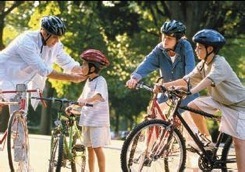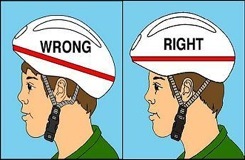
Why are helmets so important?
For many recreational activities, wearing a helmet can reduce the risk of a serious head injury and even save your life.
How can a helmet protect my head?
During a fall or collision, most of the impact energy is absorbed by the helmet, rather than your head and brain.
Are all helmets the same?
No. There are different helmets for different activities. Each type of helmet is made to protect your head from the impacts common to a particular activity or sport. Be sure to wear a helmet that is appropriate for the particular activity you’re involved in. Other helmets may not protect your head as effectively.
How can I tell which helmet is the right one to use?
Bicycle and motorcycle helmets must comply with mandatory federal safety standards. Many other recreational helmets are subject to voluntary safety standards.
Helmets certified to a safety standard are designed and tested to protect the user from serious head injury while wearing the helmet. For example, all bicycle helmets manufactured after 1999 must meet the U.S. Consumer Product Safety Commission (CPSC) bicycle helmet standard. Helmets meeting this standard provide substantial head protection when the helmet is used properly. The standard requires that chin straps be strong enough to keep the helmet on the head and in the proper position during a fall or collision. Helmets specifically marketed for exclusive use in an activity other than bicycling (for example, go-karting, horseback riding, lacrosse, and skiing) do not have to meet the requirements of the CPSC bicycle helmet standard. However, these helmets should meet other federal and/or voluntary safety standards.
Don’t rely on the helmet’s name or claims made on the packaging (unless the packaging specifies compliance with an appropriate standard) to determine if the helmet meets the appropriate requirements for your activity. Most helmets that meet a particular standard will contain a special label that indicates compliance (usually found on the liner inside of the helmet). See the table in this pamphlet for more information on what to look for. Are there helmets that I can wear for more than one activity? Yes, but only a few. You can wear a CPSC-compliant bicycle helmet while bicycling, recreational roller or in-line skating, and riding a nonpowered scooter. Look at the table in this pamphlet for other activities that may share a common helmet.
Are there any activities for which one shouldn’t wear a helmet?
Yes. Make sure your child takes off his/her helmet before playing on playgrounds or climbing trees. If a child wears a helmet during these activities, the helmet’s chin strap can get caught on the equipment or tree and pose a risk of strangulation. The helmet itself may present an entrapment hazard.

How can I tell if my helmet fits properly?
A helmet should be both comfortable and snug. Be sure that it is level on your head—not tilted back on the top of the head or pulled too low over your forehead. It should not move in any direction, back-to-front or side-to-side. The chin strap should be securely buckled so that the helmet doesn’t move or fall off during a fall or collision.
If you buy a helmet for a child, bring the child with you so that the helmet can be tested for a good fit. Carefully examine the helmet and accompanying instructions and safety literature.
What can I do if I have trouble fitting the helmet?
You may have to apply the foam padding that comes with the helmet and/or adjust the straps. If this doesn’t work, consult with the store where you bought the helmet or with the helmet manufacturer. Don’t wear a helmet that doesn’t fit correctly.
Will I need to replace a helmet after an impact?
That depends on the severity of the impact and whether the helmet can withstand one impact (a single-impact helmet) or more than one impact (a multiple-impact helmet). For example, bicycle helmets are designed to protect against a single severe impact, such as a bicyclist’s fall onto the pavement. The foam material in the helmet will crush to absorb the impact energy during a fall or collision and can’t protect you again from an additional impact. Even if there are no visible signs of damage to the helmet, you must replace it.
Other helmets are designed to protect against multiple moderate impacts. Two examples are football and ice hockey helmets. These helmets are designed to withstand multiple impacts of the type associated with the respective activities. However, you may still have to replace the helmet after one severe impact, or if it has visible signs of damage, such as a cracked shell or permanent dent in the shell or liner. Consult the manufacturer’s instructions for guidance on when the helmet should be replaced.
 Print
Print Email
Email







